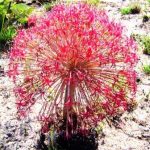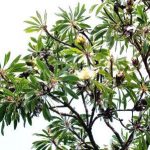TREE LIFE
April 2006
Please note that with immediate effect the post office box number for the Tree Society has changed to:
P.O. BOX A 273 AVONDALE HARARE
MASHONALAND CALENDAR
Tuesday 4th April: Botanic Garden Walk. Meet Tom in the car park at 4.45 for 5 pm..
Sunday 9th April: Please note that because of the Easter weekend the outing has been brought forward a week.
This month we are spending the day in the Mukuvisi Woodland, using the Blatherwick Road entrance, Meg Coates Palgrave will lead the group. We will meet at 9.30am.
Saturday 29th April: Please note this is the 5th Saturday, one week later than usual, Mark’s walk will be at 2.30pm. Please phone Mark for details of the venue.
Saturday 6th May: Back to winter. Groan. For the next 5 months Tom will lead the walk in the Bot Gardens on Saturday mornings at 11 am.
Sunday 21st May: A.G.M Botanic Gardens.
Saturday 27th May: Mark’s Walk – to be decided.
MATABELELAND CALENDAR
Please contact Jean Wiley or Gill Short for details of the next Matabeleland function.
SUBSCRIPTIONS ARE DUE NOW FOR 2006/7
Email Z$160,000
Printed copy: collected Z$320,000
Printed copy: posted Z$800,000
Once again, I must emphasize strongly that we do not want to lose members as a result of these increases. Each year a number of members pay more than the norm so that the excess goes anonymously to support members who may be having financial difficulties. So, please do not be proud; talk to Terry or me.
If paying by cheque, please make it out to CABS and on the reverse ‘Pay to the account of the Tree Society’
NOTICE OF ANNUAL GENERAL MEETING
Notice is hereby given that the 56th Annual General Meeting of the Tree Society of Zimbabwe will be held at the Educational Centre in the Botanic Gardens, 5th Street on 21st May 2006 at 9.30 am.
Any proposals/resolutions and nominations for office bearers should be forwarded to P O Box A 723 Avondale, Harare by Monday 15h May if possible, although proposals and nominations will be accepted from the floor.
AGENDA
1. Notice convening the meeting.
2. Apologies.
3. Minutes of the 55th A.G.M.
4. Matters Arising.
5. Chairman’s Report.
6. Treasurer’s Report.
7. Election of Committee Members.
8. Any Other Business.
CHAIRMAN’S REPORT – FOR THE AGM ON MAY 21ST 2006
I have pleasure in presenting the Chairman’s report for the year 1 April 2005 to 31 March 2006.
General
The year was one of continuing difficulties at a national level: inflation reached 782% per annum in February 2006, “inappropriately denominated bank notes” filled our wallets and made buying things extremely difficult, fuel remained expensive and difficult to obtain, farming areas were effectively closed to us and emigration continued. After so many years of reporting situations like this, it is clear that these are now the norm in Zimbabwe!
Despite this, the Tree Society managed more or less to maintain its full program of events during the period.
Outings
During the year, the serious fuel shortage that developed in June and July led to the attendance of only 3 members at the Kutsaga outing in June and also led us to cancel the outing in July. However, apart from this one missed month, a full complement of 3rd Sunday outings was held, as shown in the following table:
Month Location
April 2005 Maringambizi, Mtoroshanga
May Meikles Estate, Borrowdale (AGM)
June Kutsaga Research Station
July Cancelled
August Umwindsidale
September Ruzawi School
October Domboshawa
November Carli’s Farm, Arcturus
December Xmas Social (Bot Garden)
January 2006 Kutsaga Research Station
February Christon Bank
March Val D’Or
I am very grateful to those institutions and landowners who allowed us to visit their properties. Difficulties were continually encountered in finding and arranging suitable venues, especially new and different ones.
During the year a new concept, a “Show and Tell” evening, was successfully tried out and two such evenings were held during the year, namely in October 2005 and March 2006. Both evenings went well and interesting presentations were made by various members.
Once again, I am very grateful to both Rob Burrett and Meg Coates-Palgrave for their assistance in leading outings. Tom Muller gave his time each month to lead us in the Harare Botanic gardens with his usual humour and patience and a number of most interesting subjects were covered.
I continued to lead my 4th Saturday walks near Harare; I find I still get a lot of personal interest and satisfaction out of these.
Membership
The current membership, compared to previous years, is as follows:
MEMBERSHIP 2006 2005 2004 2003 2002 2001 2000
Ordinary Members 127 167 159 158 188 204 218
Associate Members 5 5 5 7 14 14 14
Honorary Members 5 4 6 8 9 8 8
TOTAL 137 176 170 173 211 226 240
I would like to thank Linda for continually keeping the Twinarts emails up to date. This is a great source of new members.
We report with sadness the departure for the UK of Ann Bianchi, a long-standing member of the Society, with a wide knowledge of trees. We wish her well in her new home.
Tree Mapping
Work on the Tree Mapping scheme remains somewhat in abeyance because of a lack of a suitable computer.
Tree Life
Maureen produced and edited Tree Life, sourced articles and kept the Chairman writing articles, during the year. This is, as always, a major effort and I would like to thank her for all her hard work.
During the year, the number of printed Tree Life copies gradually reduced, thereby reducing costs.
Finance
The year under review was generally satisfactory financially. Terry Fallon has continued his hard work as Treasurer and we are very grateful to him. I would also like to thank Adele for her assistance with the accounts.
Beginners’ CD
Work has begun on a CD of information (text and images) about common trees of Zimbabwe. Rob Burrett has been working on this and it is hoped to involve other members.
Web site
During the year, Mweb stopped hosting the site, but this was very kindly taken over by Odette Lind who also very generously maintains the site.
Publications
The text of Lyn Mullin’s book on vernacular plant names was handed over to publisher (Ian Murphy) and we understand that finance has been obtained.
Secretary
Maureen resigned as secretary of the Society after 19 years in that role. During that period she has been the mainstay of the Society, without whom the Society would not have functioned as well as it has. We are all immensely grateful to her and quite understand that after such a period she now feels somewhat stale.
Although she will no longer be on the Committee she has volunteered to continue with the Tree Mapping exercise and to maintain the register of members at outings.
This resignation leaves the Committee very stretched. Even before Maureen’s resignation, we were short of people. We therefore now urgently need members to come forward and assist us with the running of the Society.
In particular, a new Secretary is needed and a new editor of Tree Life. We would also like to appoint a Meetings secretary whose role would be to organize the outings.
Finally …
I would like to thank the Committee for their commitment and support during the year. Without them the Tree Society would not have functioned so well.
Mark Hyde Chairman
CHRISTON BANK: 19 FEBRUARY 2006
It was a grey start to the day as members of the Tree Society assembled in the car park at Christon Bank on Sunday 19th February. This is always a popular place with us because of its rocky and riverine habitats set in beautiful hills, all fairly close to Harare.
After the steady rains of this wet season everything was beautifully green and lush – both the leaves on the trees and the herbaceous vegetation. It was the season in which few trees are in flower and so perhaps it was a little less interesting than a couple of months earlier. The altitude of the car park was 1360 m, a bit lower than Harare.
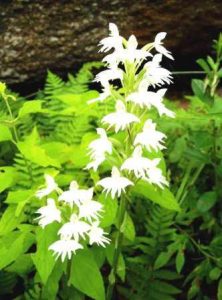
Habenaria stylites subsp. rhodesiaca. Photo: Mark Hyde. Source: Flora of Zimbabwe
Our first species of interest was a stunning white-flowered orchid growing amongst rocks quite near to the car park. This was Habenaria stylites subsp. rhodesiaca. The tall stems arise from a pair of broad leaves which are appressed to the ground. Werner explained that it is a fairly frequent species; it occurs in rocky places in sandy soils, preferring shade.
A quick look around the car park showed us the distinctive leaves of Inula glomerata. It is a late-flowering composite; at this time of the year the large leaves with their tapering undulate bases are very distinctive. The specific name means “clustered” and refers to the tightly packed clusters of yellow flower heads. It is a common species – one we saw throughout the day.
Jack led the walk and we started off by going down into the nearby valley, across the flowing stream and up into Brachystegia woodland. Four friendly dogs were our constant companions throughout the walk. After a short walk, we arrived at a fairly recently dug mine. The pit is unbelievably narrow and deep – I would not like to work at the bottom of that.
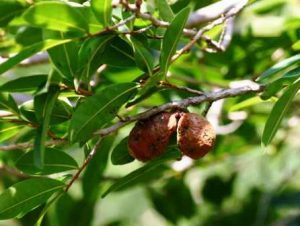
Hexalobus monopetalus. Photo: Bart Wursten. Source: Flora of Zimbabwe
In the woodland was Pericopsis angolensis (Muwanga). This showed the ‘dead branch on the right’ which marks this species. It is a frequent legume with pinnate leaves and sub-opposite leaflets and winged pods. The trunk tends to have a distinctive greyish-white bark. Amongst some rocks was Hexalobus monopetalus (Shakama plum), a shrub with dark green alternate leaves held in one plane. The latter is very much a feature of the Annonaceae and species of that family can usually be confirmed by the slightly aromatic smell of the crushed leaves.
At this stage, we moved off the path and climbed a low rocky hill. Here were clumps of a succulent orchid, Eulophia petersii. Werner gave us a talk about this plant’s life cycle, namely how it likes well-drained rocky habitats. It’s flowering stems are quite tall – up to 2.5 metres in extreme cases. Flowering is very erratic from year to year with some year producing copious flowers and others hardly any.
Also nearby was a tiny epiphyte, Polystachya greatrexii – leaves only at this stage. Werner explained that F C Greatrex, after whom the plant is named, was a retired British diplomat who had spent most of his life in Japan, where he became General Consul in Nagasaki. On coming to Zimbabwe, he set about recording the orchids around Harare. The genus Polystachya is a large genus of mainly epiphytic orchids, most of which are found in higher rainfall areas in the Eastern districts but this species is one of the few which extends into the savannah areas.
We then descended the hill by another route and saw Ficus glumosa (the Hairy rock fig). This has roundish leaves and can be recognized by its very hairy branch tips. A very common species in the Matopos but a somewhat local species in this area.
As we returned to the cars the heavens opened and at the kind invitation of Anne Lowe we all moved to her house in another part of Christon Bank. Here we had lunch under the verandah and eventually the rain stopped.
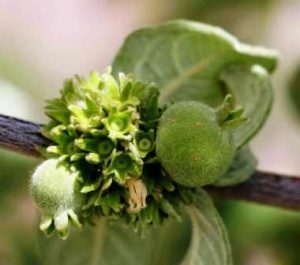
Tapiphyllum velutinum. Photo: Bart Wursten. Source: Flora of Zimbabwe
After lunch we set off for a walk near the house. After walking through some grassland, we ended up on a rocky slope, with spectacular views of mountains to the north with dark storm clouds behind. The vegetation was like that of Domboshawa: bare granite rocks, seepage zones and patches of woodland. Here was the fire bush (Hymenodictyon floribundum), the blue-flowered Plectranthus (sanguineus) so typical of rocky places and Tapiphyllum velutinum.
Also present was the distinctive little fern of rocky cracks: Actiniopteris dimorpha and the Resurrection bush (Myrothamnus flabellifolius).
We also saw a twining species of Ceropegia. These herbaceous plants have flowers whose petal tips join together to form an apical “cage”. Although over 20 species have been recorded from Zimbabwe, one rarely sees these plants – they seem to be quite local.
All in all, it was an interesting place, at which we made quite a long list of species. This would well repay a further visit.
In fact, the whole day was very interesting and pleasant one. I am most grateful to Jack for leading our walk and to Werner for talking about the various orchids seen.
-Mark Hyde
While going through some of Lynn Mullin’s botanic papers Maureen came across a record of his talk to the Tree Society given in about 1977. We are sure it will be of great interest to all members. It is fairly lengthy so will be spread over the next few issues of Tree Life.
INDIGENOUS TREES
Mr. Chairman, ladies and gentlemen I am pleased to have this opportunity of talking to you about our indigenous trees, amongst which I have lived and worked all my life, and which I grow to love more and more the better I get to know them.
It used to be a maxim in the old Forestry Department, that “the better botanist you were, the better forester”. I do feel that what little botany I know has made life, not only as a forester but also as a person, a lot more interesting. Any knowledge I have of the names of our vegetation, both botanical and vernacular, has simply been learnt from constant usage over many years. A botanist may not be a forester; but I do think every forester is perforce, somewhat of a botanist.
Although the talk will be mainly about our native trees I shall have quite a lot to say about some of the exotics grown here as a means of comparison and illustrating a certain important difference, and the very reason why exotics are necessary here – their greater rate of growth.
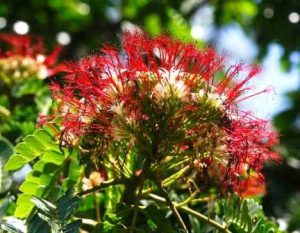
Albizia gummifera. Photo: Bart Wursten. Source: Flora of Zimbabwe
Something that has always filled me with awe is the sight of a very large tree. It has a similar effect on my senses as the sight of a very high mountain. It brings to mind the words of the Psalmist when he said “I to the hills will lift mine eyes”. There is always great beauty, dignity and grandeur in a large tree, the Cedar of Lebanon is used throughout Scripture as a symbol of grandeur, might and loftiness. I have never forgotten when in 1929, on Stapleford F.R I accompanied our first Forest Officer here the late Dr. J. S. Henkel on a walk. He stood at the foot of a huge Munjerenje Albizia gummifera and after looking up at the crown of the tree for a few seconds in deep thought slowly shook his head saying “beautiful, beautiful”.
The main theme of my talk will be the rates of growth and ages of our trees. Even the fastest growing tree takes a long time by human standards to become a real giant and then its very vastness holds one spell-bound. Here is God’s handy work. Something that only He could do. Probably some of our indigenous trees do grow comparatively quickly; but by-and-large they grow very slowly. Usually they live under very harsh conditions. – A long and dry, hot season which is often aggravated by a heavy fire-season. Even our wet season can hardly be said to drown us, and competition for what moisture there is, must be very great. Our vegetation has conditioned itself over a very long time to the vagaries of this climate, to the extent that it is only the tree with a good, tough, thick, fire-resistant bark and very deep root system that can survive. I shall have more to say about this later; though, as a sequel to what has just been said about our rainfall, it might be appropriate here to make mention of and try in some measure to answer, a question often posed to members of the commission. Do trees use a lot of water? Well! Although I have heard that a large fig-tree or Gum-tree will transpire as much as 400 gallons in a day, I cannot verify this, but can tell you of a phenomenon which happens every year in Rhodesia (Zimbabwe) proving beyond any doubt that they certainly use an appreciable quantity. The phenomenon cannot so easily be seen in Mashonaland; but is certainly easily witnessed every year in the drier parts of Matabeleland. Shortly after the cessation of our wet-season, water-holes dry up and rivers stop flowing. Then when the cold frosty weather of winter arrives the vegetation dries up, the trees shed their leaves and, quite suddenly, it will be found that the water-holes have filled up and the rivers have commenced flowing again. This may well be as long as six weeks or more after the rains ceased. This is purely because the foliage has gone and is no longer transpiring and the roots are only taking up enough from the soil to keep the plant alive. Any surplus again percolates down from the high sand ridges into the water holes and rivers, and in fact it must be this water which maintains the water-table in the area.
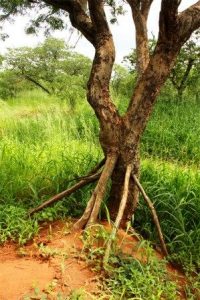
Baikiaea plurijuga. Photo: Bart Wursten. Source: Flora of Zimbabwe
I have already said that our vegetation has a very deep root system. An umkusu, Rhodesian Teak, Baikiaea plurijuga, to give it all the names I know it by, growing on top of the bank of the Gwaai river, near Matupula’s Kraal, where the bank is one hundred feet high has had its roots exposed by erosion of the sandy soil and they descend the full 100 feet down to the level of the river bed. Whether they go any deeper I do not know; but it does indicate that the trees in the area do put their roots down to a great depth probably to the water level. I should imagine that all the other species such as Mukwa, Mtjibi Pod-mahogany and Umgoma growing in the area have just such deep root systems.
Most of the trees mentioned develop best in Rhodesia (Zimbabwe) on our Kalahari sand veld. The impression I have, after many years in these areas is that seedlings of these species take many years after germination before they really show much growth above ground. During this interval, when only a few leaves are on the plant, it is busy developing a deep, strong, healthy, root system and not until this is deep enough to ensure a safe supply of water will the part above ground begin to grow. During this period the young tree has possibly also been burnt back to ground level a number of times by raging veld fires, so that by the time one sees a young sapling of one, two or three inches in diameter there is no knowing what the actual age of the plant is. These trees are tough and if complete protection from fire can be given, they will the more rapidly develop into trees.
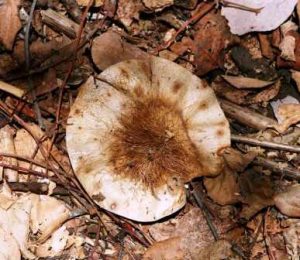
Pterocarpus angolensis. Photo: Bart Wursten. Source: Flora of Zimbabwe
Mukwa, Pterocarpus angolensis seedlings, which were grown under nursery conditions in the mid twenties on our Fuller Forest Station some twenty two miles from the Victoria Falls appeared to remain at about nine inches in height and pencil thickness for at least the first five years after germination, then growth above ground was comparatively rapid and at ten years from planting they had reached about fourteen feet in height. However, it takes about another eighty years or so before the stem reaches a merchantable diameter of say eighteen inches. There is little to suggest that any of the other species are any more rapid.
Our Msasa, Brachystegia spiciformis woodland with all its associates is painfully slow. There is a tree at the school in Melsetter, now 20 inches in diameter which, over the last 50 years does not appear to me to have put on any growth at all. I suppose it must have done, but certainly not more than an inch or two. By comparison there is an English Oak, Quercus pedunculata, in the village the acorn of which was brought out from England and sown by Mr. Hoale in 1902. This tree is now over four feet in diameter. I was astounded, after seeing such rapid growth in the Oak, to see so little if any difference in the Msasa. A similar example, much nearer home, is the Msasa in the middle of North Avenue just east of Second Street I have never found anyone, even very old residents, who can recall when it was any smaller. I was speaking to Mr. George Schlachter about a fortnight ago about the tree in Melsetter (Chiminimani) when he drew my attention to the one in North Avenue. He said he had known that tree for over 55 years and he could not remember it any different from what it is now.
I feel it is a shame that early foresters stationed in Salisbury (Harare) did not record diameters of some of the local trees. These records would become more and more interesting and valuable as the years go by. I have now got the measurements of a few but it is a late start and it will be many years before they prove anything. I believe a rough estimate of the age of most of our large Savannah trees can be reached by finding the diameter in inches and multiplying by five. Thus a 10 inch tree is probably 50 years old, a 20 inch 100 years old. This rule of thumb may well be a long way out with some species; but I have made a lot of ring counts from time to time on a number of species and this has been my finding.
-Lyn Mullin To be continued.
Wanted: articles for Tree Life …
TREE LIFE NEEDS YOU – or rather it needs your input. Articles, notes, comments, questions, observations – all are welcome.
Your contribution needn’t be long or weighty – a simple note or observation is often of great interest.
Don’t be put off by thinking you don’t know enough. Sit down and pen something today!
MARK HYDE CHAIRMAN


